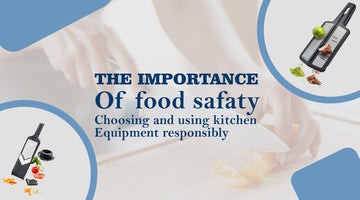Essential Guide: Proper Use and Storage of Non-Stick Pans for Longevity
by Michele Ekins on Dec 11, 2024

A combination of availability, convenience and value for money are the top reasons that makes non-stick pan popular and a must have in your kitchen. But the major drawback is that non-stick pans don’t last forever. Incorrect storage, scratches and abrasive cleaning may lead to replacing it once after the coating starts to peel off.
To overcome this, you need to understand how to properly use and store non-stick pans to maximize its lifespan and stay in excellent condition for years to come. This guide will help you to learn best practices of non-stick pan care, cleaning non-stick pans and proper use of non-stick cookware.
How to Properly Use and Store Non-Stick Pans?
Proper usage and storage of non-stick pans ensure they perform well, last longer and remain safe for cooking. It is essential to handle non-stick pans with care to maintain their non-stick properties.
These are ways of preventing non-stick pan damage for extending non-stick pan lifespan.
1. Avoid using dishwasher
Although every non-stick cookware claims to be dishwasher safe, using extremely hot water and strong detergents will reduce the non-stick pan's lifespan. To extend its life, avoiding scratches on non-stick surfaces is essential as harsh washing methods can cause damage.
The coating of a non-stick pan will disintegrate over time considerably more quickly if it is exposed to these conditions than if it is washed by hand.
2. Do not Immerse hot non-stick pan in water
This is to prevent thermal shock, which occurs when a quick change in temperature stresses the non-stick coating and pan.
A pan shouldn't be cooled down too soon, just as it should not be heated up too quickly or over high heat.
3. Cooking over a high-heat
The surface of the non-stick pan will eventually get damaged from exposure to high heat. This type of damage is simple to identify. The non-stick surface turns discolored and in severe situations, peels or blisters are shown off the pan.
Furthermore, you should never let food burn on your non-stick pans. Cooking at high non-stick pan cooking temperatures can cause the non-stick coating to weaken if burning occurs.
4. Pre-heating an empty non-stick pan
A lot of people simply turn on the hob, put the pan on the heat and then add some oil once it is hot. However, most pans can achieve extremely high temperatures in just a few minutes which may lead to the non-stick coating breaking down.
To prevent this, it's important to follow non-stick pan preheating guidelines such as heating the pan gradually over medium to low heat to ensure the coating stays intact.
5. Season your non-stick pan before the first use
Seasoning a non-stick pan like the Eco Ok Wok Pan ECO2811 before its first use is crucial for maintaining a durable and effective non-stick surface. This process helps create a smooth, consistent layer that prevents food from sticking.
Start by cleaning the non-stick pan with mild dish soap and a soft sponge, then dry it thoroughly. Apply a thin layer of vegetable oil and heat the pan over medium heat for about 30 seconds. Let it cool and wipe off any excess oil before use.
6. Choose the Right Utensils
Choosing the best utensils for non-stick pans such as wooden spatulas or spoons are essential to avoid damaging their protective coating. Products like the Eco Ok Fry Pan 9.5" ECO2694 pair perfectly with silicone-coated utensils that are both flexible and non-stick friendly.
Tongs with soft, padded grips and heat-resistant materials like silicone or stainless steel are also great options.
Non-stick pan storage solutions
- Cleanliness: Always clean and dry your non-stick pans after use to prevent bacterial growth and maintain the non-stick coating.
- Use Pan Protectors: Place paper towels, pan protectors or soft cloths between pans to prevent scratching and damage.
- Avoid Stacking: Don’t stack non-stick pans on top of each other without a protective layer in between. This can cause scratches that affect the pan’s non-stick performance.
- Hang or Organize: Consider hanging your non-stick pans using hooks or pan organizers to keep them separate and protected.
Non-Stick Pan Cleaning Methods
Maintaining your non-stick pan is essential for its longevity and optimal performance in your kitchen. Understanding proper cleaning methods not only extends the life of your cookware, but also ensures safe and healthy cooking.
This includes knowing the non-stick coatings types, recognizing non-stick pan replacement signs and following important non-stick pan safety tips.
- Vinegar and Baking Soda Method: Mix 2 tablespoons of white vinegar with 1 tablespoon of baking soda and 1 cup of water. Bring the mixture to a boil, then reduce heat and simmer for 5 minutes. Let the pan cool, then rinse and wash with soap and water.
- Soap and Water Method: Wash the pan with mild dish soap and warm water. Use a soft sponge or cloth to scrub away any food residue. Rinse thoroughly and dry with a towel.
- Baking Soda and Dish Soap Method: Make a paste with baking soda and dish soap. Apply the paste to the burnt or sticky area and let it sit for several hours. Wash with soap and water and dry with a towel.
Conclusion
Proper use and storage of non-stick pan is crucial for extending their lifespan and maintaining its non-stick properties. By following these guidelines, you can ensure your non-stick pan remains in excellent condition, performs optimally and provides years of hassle-free cooking.
Remember to inspect your pans regularly and replace them if necessary to maintain food safety and optimal performance.
We at Gourmet Kitchenworks offer a wide range of high-quality kitchen appliances that aim to deliver a combination of aesthetic design and ease of use.
We work by offering a curated selection of top-tier kitchen appliances from various trusted brands ensuring quality and innovation. They provide customers with diverse choices to create the ultimate cooking experience tailored to their needs.
FAQs (Frequently Asked Questions)
Q: How do I clean a non-stick pan without scratching it?
A: To clean a non-stick pan without scratching, use a gentle soap and a soft sponge or cloth, avoid scouring pads and harsh chemicals, and dry the pan thoroughly after washing to prevent water spots and mineral deposits.
Q: Can I put my non-stick pan in the dishwasher?
A: No, it's generally not recommended to put non-stick pans in the dishwasher, as high-pressure jets of hot water and harsh detergents can damage the coating of non-stick pan causing it to peel or leak into food.
Q: What utensils are safe for non-stick pans?
A: Wooden, silicone and nylon utensils are recommended, as they are gentle and won’t scratch or damage the non-stick coating, while plastic utensils are also safe to use. But metal utensils should be avoided.
Q: How do I prevent food from sticking to a non-stick pan?
A: Preheat the pan, apply a small amount of oil or cooking spray, and make sure the surface remains moist by adding oil or water as needed especially when cooking methods involve high heat cooking times.
Q: How can I safely store my non-stick pans?
A: Store them in a cupboard with a soft cloth or pan protector between each pan to prevent scratching and avoid storing them near abrasive materials.
Q: How do I know when my non-stick pan needs replacement?
A: When the coating starts to peel off, flake or show visible scratches or when it no longer releases food easily, commonly after an average lifespan of 2 years of ceramic-coated pans.




